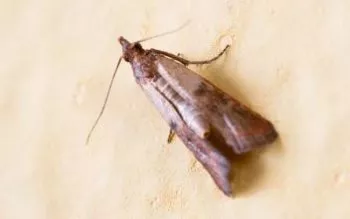 An Indian meal moth infestation is a problem that most people don’t ever think about until it hits them. Of all of the pantry pests living in Eastern & Central VA, Indian meal moths are one of the most important to watch out for. These moths feed and breed in boxes of dry food products, often remaining concealed until their infestation’s numbers grow to numbers we have no choice but to notice. If you’re noticing small, white, larval insects or moths with maroon-tinged wings in your kitchen or cupboards, read on. The pantry pest exterminators at Loyal Termite & Pest Control are here to teach you more about Indian meal moths and how to get rid of them.
An Indian meal moth infestation is a problem that most people don’t ever think about until it hits them. Of all of the pantry pests living in Eastern & Central VA, Indian meal moths are one of the most important to watch out for. These moths feed and breed in boxes of dry food products, often remaining concealed until their infestation’s numbers grow to numbers we have no choice but to notice. If you’re noticing small, white, larval insects or moths with maroon-tinged wings in your kitchen or cupboards, read on. The pantry pest exterminators at Loyal Termite & Pest Control are here to teach you more about Indian meal moths and how to get rid of them.
How to Identify Indian Meal Moths
The problem with Indian meal moths is that they are a bother in both their larval and fully-formed stages. You have to learn to identify both of them in order to act quickly to take out your infestation. Here are some ways to identify Indian meal moth larvae and adults:
- Larvae: In their larval stage, Indian meal moths have cream-colored bodies with reddish-brown heads. As the larvae of moths, they have caterpillar type bodies, but they barely extend longer than 1 cm in length. You can find them writing around in stored grain products, cereals, flour, and similar goods in your pantry.
- Moths: In the same places that you’ll find larvae and more, Indian meal moths will show up when your infestation has stuck around for a while. They have wings with distinct white and maroon sections and reach about 2 cm in length at the most.
Tips for Preventing Indian Meal Moths
The problem with pantry pests like Indian meal moths is that it’s hard to know you’ve gotten rid of all of them without tossing all of your food. The best control is prevention—here’s how you can keep them out of your home to begin with:
- Check for damage on boxes of food that you purchase
- Never leave food out in the open after eating
- Use airtight containers to store your food
- Keep your pantry doors closed whenever possible
- Ensure that all of your door and window screens are intact
- Seal any cracks or gaps that lead into your home
Need Pantry Pest Control?
If you can’t seem to get rid of the Indian meal moths in your home, reach out to your local residential exterminators. Our team at Loyal Termite & Pest Control knows the ins and outs of pantry pests in Eastern & Central Virginia, so we can help you identify what caused their arrival in your home in the first place and teach you how to avoid these problems going forward. Call us today for a free quote!
